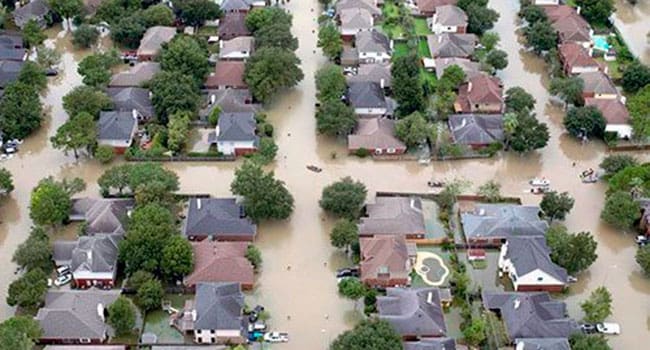 It would be callous to respond unsympathetically to the Houston and area hurricane and flood, and the consequences: death, general privation, lack of drinking water and electricity, properties and personal items destroyed. But a clear perspective on the circumstances is needed.
It would be callous to respond unsympathetically to the Houston and area hurricane and flood, and the consequences: death, general privation, lack of drinking water and electricity, properties and personal items destroyed. But a clear perspective on the circumstances is needed.
It’s been claimed that the magnitude of the tragedy was unpredictable, but surely everyone knew that hurricanes and huge floods are probable along the Gulf Coast. Hurricane Katrina in New Orleans in 2005 is a good example. So too is the fact that an area of West Houston (Memorial City), although outside Houston’s 500-year floodplain, flooded three times in the past decade: in 2009, 2015 and 2016.
Astonishingly, the potential for such an event was all but ignored by disaster planners, in spite of expert reports. The former head of the Harris County Flood Control District said that “scientists ‘have an agenda’ and that ‘their agenda to protect the environment overrides common sense.’”
According to the Houston Press, the same person “flat-out disagrees with scientific evidence that shows development is making flooding worse. Engineering projects can reverse the effects of land development and are doing so. The claim that ‘these magic sponges out in the prairie would have absorbed all that water is absurd’.” (Of course no one was suggesting the latter point.)
Media coverage has concentrated on human stories and descriptions of the cost and length of time needed for reconstruction. I believe that deeper analysis is needed.
For example, commentators might point out the increased frequency of extreme weather events and relate the Houston storm to those in Bangladesh and elsewhere (Windsor, Ont., has had two historic floods in the past year). While scientists are cautious about attributing any particular weather event mainly to global warming, the trend is ominous, particularly as sea levels rise. It should be obvious even to the dimmest decision-makers that the more heat the oceans contain, the greater the energy available for tropical storms and historic rainfalls.
These facts mean that planners should anticipate much bigger and more frequent extreme weather challenges. As a general principle, we need to accommodate natural forces and try to mitigate their damage instead of pretending that heroic engineering projects will prevent it.
Cities like Houston that permitted development of low-lying wetlands made a catastrophic mistake. For example, the watershed area of the White Oak Bayou river, which includes much of northwest Houston, lost more than 70 per cent of its wetlands from 1992 to 2010.
But what needs to be done?
In modern cities like Houston or Calgary, the city core and large residential communities can’t be moved. But answering some questions might help governments decide how to proceed with reconstruction.
- Should buildings that were destroyed or badly damaged be rebuilt? Or should they be purchased (by expropriation if necessary) and converted to parkland and natural areas?
- What requirements should be imposed on owners who wish to rebuild less seriously damaged structures? That they include some form of flood-proofing? That they be insured? That they will be ineligible for flood relief funds in future? That caveats be registered against their land to warn future buyers?
- What criteria should be used for extending financial help or government purchasing?
- What proportion of government aid should be spent on general construction to reduce future flood damage, such as berms, more pump capacity, dry storage or, in extreme cases, bypasses like “Duff’s ditch” diverting excess flows in the Red River past Winnipeg?
Surely no (re)construction should be allowed in the most low-lying areas, unless demonstrably adequate flood-proofing is provided.
More rigorous watershed planning to protect against future floods would also help. Forest clearcutting or hard-surfaced development reduce water absorption and cause more and faster runoff. On the other hand, preserving natural watershed features contribute greatly to water retention. More expansive floodplain maps and more rigorous planning controls over those threatened areas are needed.
Media could also publicize reports of experts who warned about complacent failure to prepare for floods and suggest lessons to be drawn from the catastrophe.
Perhaps federal aid should be conditional on the firing of agency decision-makers who rejected expert warnings, and/or signed pledges by state and local governments that a stipulated list of preventive measures will be undertaken. In fact, redesigning damaged areas could tremendously improve neighbourhoods and cities. Mindless replacement of inadequately designed neighbourhoods is not good enough.
We landlocked people in Alberta have no reason for complacency. Even after the Calgary flood of 2013 and the joint fire and flood catastrophes in Fort McMurray in 2016, it’s by no means clear that the necessary holistic planning and courageous decision-making are happening.
For example, the Calgary Next boosters of a new hockey rink and athletic complex originally proposed a site within a stone’s throw of the Bow River’s low southern bank! And in Fort McMurray, according to the Edmonton Journal, “amendments to the land-use bylaw allow residents to rebuild their homes to their pre-existing construction standard anywhere in Waterways. Restrictions on any new development on the Waterways flood plain – put in place following new provincial flood legislation in 2013 – were removed.”
Choosing optimum flood management strategies needs careful evaluation of cost, effectiveness, and environmental and social impacts, as well as their ethical considerations.
Phil Elder is emeritus professor of Environmental and Planning Law with the Faculty of Environmental Design at the University of Calgary.
Phil is a Troy Media Thought Leader. Why aren’t you?
The views, opinions and positions expressed by columnists and contributors are the author’s alone. They do not inherently or expressly reflect the views, opinions and/or positions of our publication.

